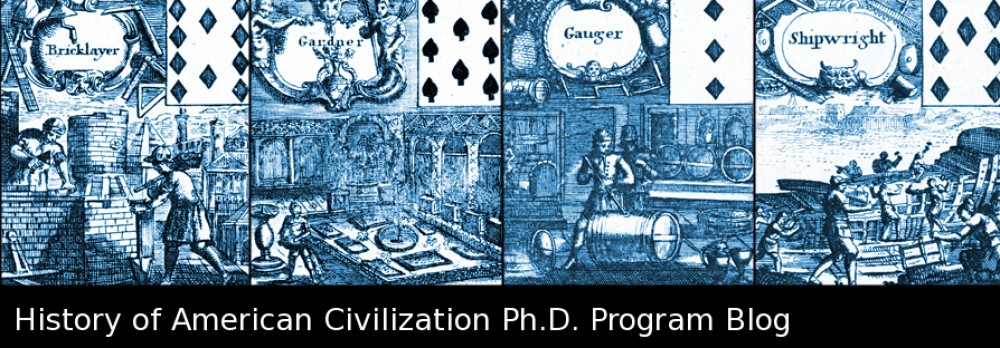The Second World War generated a lot of paper. You still see it all over the place, littering antique stores and yard sales. I’m not an avid collector of such ephemera, but, almost without noticing, I’ve developed a pretty substantial stack of the stuff over the years. This past semester, when I was a teaching assistant for HIST 206, U.S. History Since 1865, it occurred to me that I might put all these books, pamphlets, calendars, and cards to a better use than gathering dust. It’s not the first time I’ve tried using objects in the classroom. A couple years ago, when I was teaching an archaeological field school in Ohio, I brought in a bunch of artifacts I once collected on the Thames foreshore in London. I asked the students to analyze the artifacts without knowing anything about their context, or where they were discovered. The lesson I wanted to drive home was how important an artifact’s provenience (it’s former location in the ground) is to archaeological conclusions.
This semester, I taught two discussion sections each week. Typically, these involved mini-lectures, multimedia, and reading discussions, so I wanted to ease the students into analyzing material culture slowly. Most of them were newcomers to history, let alone the nuances of material culture, so I worried they might have trouble interpreting complex WWII artifacts such as a helmet or a bakelite compact. So I brought in a dozen books, pamphlets, and other pieces of ephemera dating to WWII, all of which, besides having distinctive physical traits as objects, featured ample printed text. As I passed the objects around to pairs of students, I explained the assignment: to describe and interpret these pieces of WWII history. Each group discussed their objects and presented them to the class.
Some of the WWII items my students analyzed.
For material culture novices, the students made some very astute observations. Some of them noticed that the soldiers’ Bibles, designed for field service, were small and sturdy. Others pointed out the positive and inspirational messages of the music in a songbook. They asked questions about food and gasoline shortages when confronted with booklets of ration stamps. Some pointed out the reassuring subtext in an Air Corps officer’s letter home. They puzzled over the backstory behind a Christmas card from “Betty, Joanna, and Betts Paddock [and] Major Bob, overseas.” They mused over why a set of V-mail letters, from an M.P serving in the Pacific, might have been miniaturized for mailing home (here’s the answer). They enjoyed the tips from General Motors on how to conserve gasoline and tires. One sharp-eyed student, a veteran himself, noticed how all of the sweaters and vests in a knitting guide were named after famous military generals and pointed out how the 1940 Bluejackets’ Manual, a comprehensive how-to guide for Navy sailors, seemed remarkably similar to the Airman’s Manual he was issued just a couple of years ago. The students laughed about how a 1943 kitchen calendar with decadent recipes gave no indication of wartime food rationing.
A lesson like this is effective for several reasons. First of all, the students examined an array of material that touched many different aspects of life during WWII. Moreover, using original objects makes the past seem physical, something you can see and touch. The following week, a student asked me where all that stuff had come from and why I had it at all. That’s a sharp question, especially when you consider that most non-history major undergraduates typically encounter history through a textbook, not in an antique store or even a museum. Most importantly, in my mind, the workshop fostered a collaborative learning environment. I could have told the students about the results of food rationing, about the multiplicity of military manuals, about the mobilization of women on the homefront, or about soldier life in the Pacific. But this way, they noticed things themselves, made observations, floated hypotheses, and asked perceptive questions. They learned not from a traditional lecture but from a dialogue among themselves prompted by the objects. I directed the conversation and filled in the occasional gap. They noticed things about the material that I never had, and I’ve owned this stuff for years. In the end, I learned a lot, too.
Tyler Putman is an Am. Civ. Ph.D. student currently taking courses and is working this summer on the “First Oval Office” project at Colonial Williamsburg.


